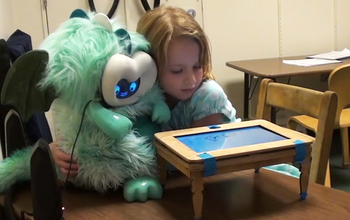Multimedia Gallery
Storytelling companion
A child interacts with a social robot modeled as a peer. Researchers are investigating whether a social robot modeled as a peer can be an effective and engaging language learning/teaching companion for young children.
More about this image
Helping children improve their language and vocabulary skills early on could help them succeed later in middle and high school. Learning a language is a very social and interactive activity, and social robots could have great impact in this area since they can leverage the same kinds of social cues and presence that people use.
In a study conducted by the Personal Robotics Group, researchers had a robot play a storytelling game on a tablet with individual children. The game showed several characters that the robot or child could move around while telling the story. During the game, the robot introduced new vocabulary words and modeled good story narration skills.
Seventeen children played the storytelling game individually with the robot, eight times each, over a two-month period. With half the children, the robot adapted its level of language to the child’s level so that as children improved their storytelling skills, so did the robot. The other half played with a robot that did not adapt.
The researchers sought to find if the adaptation influenced whether the children learned new words from the robot, the complexity and style of the stories children told, and the similarity of the children’s stories to the robot’s stories.
Results of the study showed that all of the children learned new vocabulary words, created new stories during the game and enjoyed playing with the robot. In addition, the children in the adaptive condition maintained or increased the amount and diversity of the language they used during interactions with the robot more than the children who played with the non-adaptive robot.
Understanding how the robot influences children's language--and how a robot could support language development--will inform the design of future learning/teaching companions that engage children as peers in educational play.
The research was supported by the National Science Foundation's Expeditions in Computing program (grants IIS 15-23118 and IIS 11-38986). (Date image taken: 2015-2016; date originally posted to NSF Multimedia Gallery: Aug. 8, 2016)
Credit: Personal Robotics Group/MIT Media Lab
Images and other media in the National Science Foundation Multimedia Gallery are available for use in print and electronic material by NSF employees, members of the media, university staff, teachers and the general public. All media in the gallery are intended for personal, educational and nonprofit/non-commercial use only.
Images credited to the National Science Foundation, a federal agency, are in the public domain. The images were created by employees of the United States Government as part of their official duties or prepared by contractors as "works for hire" for NSF. You may freely use NSF-credited images and, at your discretion, credit NSF with a "Courtesy: National Science Foundation" notation.
Additional information about general usage can be found in Conditions.
Also Available:
Download the high-resolution JPG version of the image. (422.9 KB)
Use your mouse to right-click (Mac users may need to Ctrl-click) the link above and choose the option that will save the file or target to your computer.

